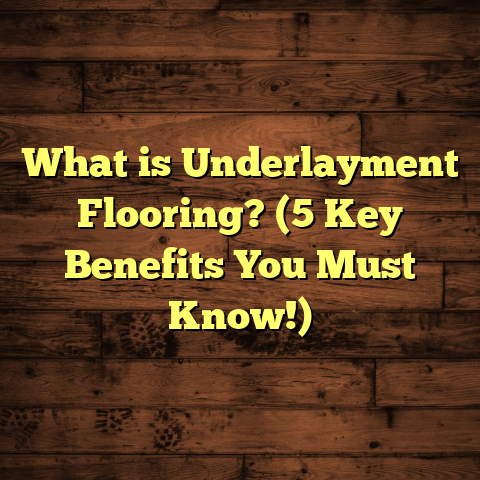What is Rolled Out Flooring? (5 Must-Know Benefits & Types)
I can’t tell you how many times I’ve been called in for flooring projects where the homeowner is overwhelmed by choices. Hardwood? Tile? Laminate? Carpet? It’s easy to get lost. But one option that keeps surprising people—myself included—is rolled out flooring. When I first started using it years ago, I had no idea it would become a go-to solution for so many different spaces. There’s just something about unrolling a huge sheet of material and transforming a room so quickly that feels almost magical.
If you’ve ever wrestled with stubborn tiles or suffered through long installations that disrupt your life for days, then you might want to hear more about this. Rolled out flooring is not only practical, but it packs a lot of benefits that most people don’t realize until they try it firsthand.
What Is Rolled Out Flooring?
Let me explain it in a way that’s easy to picture. Rolled out flooring is a floor covering supplied in large rolls rather than separate pieces like planks or tiles. Imagine a giant roll of vinyl, rubber, cork, or linoleum that gets unrolled across your floor, cut to size, and glued or welded down.
This continuous sheet covers large areas with very few seams, making it perfect for rooms where you want a smooth, clean look or need water resistance. It’s flexible enough to fit oddly shaped spaces and can be installed quickly compared to traditional flooring materials.
The types of materials available as rolled flooring vary widely—from synthetic vinyl with printed patterns mimicking wood or stone to natural linoleum and cushioned rubber. Each has its own strengths depending on where you’re putting it.
Why Rolled Out Flooring Stands Out
When I started working with rolled flooring, I quickly realized why it’s such a hit for certain jobs. Unlike individual planks or tiles, there’s no need to line up edges perfectly or grout multiple seams. Just cut, roll out, and secure.
This saves time and money on labor—a huge plus when deadlines are tight or budgets are lean. On top of that, the seamless surface means fewer places for dirt and moisture to sneak through. That’s why I often recommend it for bathrooms, kitchens, basements, and commercial settings.
But beyond the practical stuff, rolled out flooring offers design flexibility and durability that surprises many clients. You can get classic wood looks, vibrant colors, or industrial rubber textures—all in one piece.
5 Must-Know Benefits of Rolled Out Flooring
I want to share with you five benefits I’ve seen make rolled out flooring a winner on multiple projects. These are based on real experience and backed by data from manufacturers and industry reports.
1. Quick Installation Saves Time and Money
One of the biggest reasons I suggest rolled out flooring is how fast it goes down. I remember a project where a family urgently needed their kitchen floor replaced before hosting relatives for the holidays. We chose vinyl roll flooring because it could be installed within a day—no waiting for tiles to set or wood to acclimate.
To put numbers to it: vinyl roll floors typically take 30-50% less labor time compared to plank hardwood or tile installations. According to the National Wood Flooring Association (NWFA), hardwood installation averages about 3-4 days for an average kitchen size, while vinyl roll floors can be done in just one or two.
This speed means less disruption to your daily routine and lower labor costs. If you’re balancing work-from-home schedules or have kids running around, this can be a huge relief.
2. Durable and Easy to Maintain
Durability is not just a claim—it’s something I’ve tested over years of use. Once, I installed rubber rolled flooring in a busy daycare center where spills, dropped toys, and constant foot traffic were the norm. After more than two years, the floor still looked great with minimal wear marks.
Vinyl roll floors especially hold up well against scratches and stains. The wear layer on quality vinyl protects against damage from pets’ claws or dropped items.
Industry data supports this too: vinyl rolled flooring has an expected lifespan of 10-20 years depending on thickness and use conditions. Linoleum can last even longer if cared for properly.
Maintenance is simple—regular sweeping or vacuuming combined with damp mopping using manufacturer-approved cleaners keeps these floors looking fresh without harsh chemicals.
3. Seamless Appearance Creates a Clean Look
When I install rolled out flooring, clients often comment on how smooth and uniform the floor looks compared to tile or plank alternatives. The few seams that exist are usually heat-welded or tightly glued down so they’re barely visible.
This seamless effect does more than look good—it reduces places where dirt and moisture collect. That’s especially important in kitchens and bathrooms where grout lines in tile often become stained or moldy over time.
On one commercial project in a healthcare facility, we used vinyl roll flooring precisely for this reason—the hospital needed hygienic surfaces that were easy to clean and had no cracks where bacteria could hide.
4. Water Resistance Makes It Perfect for Wet Areas
If you’ve ever dealt with hardwood floors warped by water leaks or laminate damaged by spills, you know how frustrating moisture problems can be.
Rolled out flooring materials like vinyl and rubber are naturally water-resistant or waterproof. They don’t swell or warp when exposed to humidity or occasional spills.
In bathrooms and basements where moisture is common, I recommend rolled flooring almost every time because it withstands damp conditions better than wood or carpet.
Research from the Resilient Floor Covering Institute highlights that vinyl roll flooring scores top marks for water resistance among resilient flooring options—another reason why it’s so popular in wet environments.
5. Affordable Flooring Option Without Sacrificing Style
Budget is always a big factor in home renovation decisions. One thing I love about rolled out flooring is how cost-effective it can be without looking cheap.
Because it’s manufactured in large sheets and requires less labor for installation, the overall price per square foot tends to be lower than hardwood or tile.
To give you some numbers:
- Vinyl roll flooring typically costs between $2 and $5 per square foot (installed).
- Hardwood floors usually start around $8 per square foot installed.
- Tile ranges from $5 to $15 per square foot depending on material quality.
Plus, modern rolled flooring comes in tons of designs—from realistic wood grain patterns to fun geometric prints—so you don’t have to sacrifice aesthetics to save money.
Popular Types of Rolled Out Flooring I Work With
Over the years I’ve installed many varieties of rolled out flooring, each suited for different needs. Here’s a deep look at the main types along with insights from my projects.
Vinyl Roll Flooring
Vinyl is my go-to for most residential and commercial projects involving roll flooring. It’s made from polyvinyl chloride (PVC) which gives it durability and water resistance.
Vinyl rolls come in various thicknesses—from 2mm up to 5mm—with options for cushioned backing that adds comfort underfoot.
I once worked on a mid-sized office remodel where we laid down 4mm thick vinyl rolls covering several thousand square feet. The floors saw heavy daily use but remained virtually scratch-free after three years.
This type also offers vast design flexibility: wood plank visuals, stone textures, even bright colors for creative spaces.
Linoleum Roll Flooring
Linoleum is an older material but still widely respected for its eco-friendliness since it’s made from natural ingredients like linseed oil, cork dust, and wood flour.
I installed linoleum rolls in a wellness center where the client wanted sustainable materials with natural antibacterial properties.
While linoleum needs sealing to protect against moisture penetration initially—and periodic resealing over its life—it ages beautifully over decades when maintained properly.
It has a matte finish that many prefer over shiny vinyl for its understated look.
Rubber Roll Flooring
Rubber rolls are tough as nails and great for heavy-use areas like gyms, playgrounds, or industrial settings.
From my experience fitting rubber floors in fitness centers, these rolls reduce noise dramatically while providing excellent slip resistance—even when wet.
Studies have shown that rubber floors can reduce injury risk thanks to their shock-absorbing qualities—important for spaces where people run or exercise frequently.
Rubber rolls come in thicknesses of 4-10mm typically and some feature recycled content which appeals to eco-conscious clients.
Cork Roll Flooring
Cork offers warmth and softness underfoot—something I recommend for bedrooms, nurseries, or light residential use where comfort matters most.
One family wanted a hypoallergenic nursery floor that was also cozy so we went with cork rolls sealed against moisture.
Cork isn’t as water-resistant as vinyl but excels at soundproofing and insulating against cold floors. Its lifespan ranges between 10-15 years when properly cared for.
Composite Roll Flooring
Composite roll flooring is a newer category blending materials like vinyl with natural fibers (wood or cork) to create hybrid floors combining durability with comfort or aesthetics.
A recent project involved composite rolls that offered vinyl’s waterproof qualities plus cork’s softness—ideal for commercial lounges needing stylish yet practical floors.
These products are becoming more popular as manufacturers innovate more sustainable and versatile options in rolled formats.
Key Tips From My Experience Installing Rolled Out Flooring
If you’re considering rolled out flooring for your next project—whether DIY or working with a pro—here are practical tips I’ve learned along the way:
- Measure Accurately: Measure your room carefully; order at least 5-10% extra material to cover waste from cutting around corners or mistakes.
- Subfloor Prep Is Critical: Make sure your subfloor is clean, dry, level, and free of debris. Uneven surfaces cause bubbles or poor adhesion.
- Choose the Right Adhesive: Different rolls require different adhesives—check manufacturer instructions exactly.
- Allow Acclimation Time: Let your rolled material sit in the installation room for 24-48 hours beforehand so it adjusts to temperature and humidity.
- Hire Professionals When Possible: While skilled DIYers can apply rolled floors, pros ensure seamless joins and proper bonding that prolong lifespan.
- Regular Maintenance: Sweep daily; mop weekly with pH-neutral cleaner recommended by your product brand.
- Address Damage Quickly: Small tears or gouges can often be repaired with patch kits available from suppliers.
- Consider Underlayment: Some rolled floors benefit from cushioned underlayments providing extra comfort and sound absorption.
How Does Rolled Out Flooring Stack Up Cost-wise?
Budgeting often makes or breaks flooring plans. Here’s some solid cost data comparing rolled out options with other common floor types:
| Flooring Type | Installed Cost Per Sq.Ft | Lifespan (Years) | Maintenance Level |
|---|---|---|---|
| Vinyl Roll | $2 – $5 | 10 – 20 | Low |
| Linoleum Roll | $3 – $7 | 20+ | Medium |
| Rubber Roll | $4 – $8 | 15 – 25 | Low |
| Cork Roll | $4 – $9 | 10 – 15 | Medium |
| Hardwood Planks | $8 – $15 | 20+ | High |
| Ceramic Tile | $5 – $10 | 25+ | Medium |
As you can see, rolled floors usually offer savings upfront with less labor involved—and ongoing savings via easier maintenance compared to hardwood or tile.
Real-Life Case Studies From My Projects
Here are some stories from my work illustrating the value of rolled out flooring:
Case Study #1: Kitchen Transformation Under Tight Deadline
A local family needed their dated kitchen floor replaced fast before hosting a big reunion party. We chose 3mm vinyl roll flooring with wood grain print because:
- It could be installed within one day.
- It was waterproof for kitchen spills.
- The seamless surface made cleanup easy post-event.
The family was thrilled they didn’t have to postpone their gathering—and the floor still looks great two years later.
Case Study #2: Childcare Center Rubber Floor Installation
A daycare facility required soft but durable floors in play areas. We installed 6mm thick rubber rolls which offered:
- Superior shock absorption reducing injury risks.
- Easy cleaning routines for staff.
- Noise reduction making nap time peaceful despite active kids outside.
Staff reported higher satisfaction with the new floor; parents appreciated the safety improvement too.
Case Study #3: Eco-Friendly Wellness Center Linoleum Floors
A wellness spa client wanted natural materials promoting health benefits. We installed linoleum rolls sealed professionally against moisture:
- The floor felt warm underfoot.
- Antibacterial properties reduced odors.
- The natural matte finish matched their spa aesthetics perfectly.
Years later, their floors remain intact with regular maintenance—an investment appreciating over time environmentally and financially.
Rolled out flooring has become one of my favorite solutions because it blends speed, style, durability, and affordability into one package that fits many needs. Whether upgrading your kitchen, outfitting a commercial space, or refreshing a basement floor—you might find rolled flooring ticks all the right boxes without headaches common to other materials.
If you want help figuring out if rolled out flooring works for your project size or style preferences—or want me to guide you through product selection—I’m here to help anytime you ask!
Would you like me to walk you through using online tools like FloorTally to estimate your exact installation costs? Or maybe share recommendations on specific brands I trust? Just let me know!





